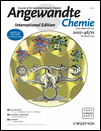siRNA Delivery into Human T Cells and Primary Cells with Carbon-Nanotube Transporters†
We thank the NIH AIDS Reagent Program for providing the three human T cell lines and two MAGI cell lines. This research was supported in part by the Ludwig Translational Research Program at Stanford University and a grant from the NIH/NCI Center for Cancer Nanotechnology Excellence (CCNE). siRNA=short interfering RNA.
Graphical Abstract
Special delivery: Functionalized single-walled nanotubes (SWNT) can be used as molecular transporters to shuttle short interfering RNA (siRNA) into human T cells and primary cells and silence the expression of HIV-specific cell-surface receptors and coreceptors (see picture; scale bars 40 μm). This silencing effect, known to block HIV viral entry and reduce infection, is superior to that observed with conventional liposome-based nonviral delivery agents.





